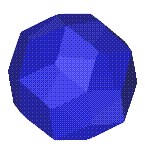|
|

 Basic
Program Features
Basic
Program Features
A variety of features make Wulffman both easy to use and
powerful.
- Simple graphical user interface
All code functions are controlled from a main window, which
spawns individual tool windows through which Wulffman is operated.
- Extensive on-line help menus
- Simple point group symmetry input
- Predefined crystallographic groups
- Predefined icosahedral groups
- User-defined (non-)crystallographic groups
Point groups can be selected through a simple interface
where the user simply selects a crystal system and then a group within
that system. User-defined groups can be built by specifying rotation
or roto-inversion axes, mirror planes, and global inversion symmetry.
- Intersection of multiple Wulff shapes
Wulffman can keep track of multiple shapes each of which can
have different symmetries and facet planes. It can then
selectively intersect these shapes to model inclusions of one
material in another.
- Dynamic Wulff shape
construction
By specifying dynamic Wulff shape construction the user can
modify the surafce energy of facets and watch the Wulff shape evolve
under the specified changes. This allows for a clear demonstration of
the effects of surface energy anisotropy on Wulff shapes.
- Isotropic surface smoothing
In many cases, only a few surface energies will be specified.
With Wulffman, it is possible to require isotropic surface energy (set
by the user) for all other facets. In this way, one can
build partially-faceted structures with smooth connecting regions.
- Measurement of Wulff shape properties
Using the Measure module to
Geomview, it is possible to measure all of the properties of a given
Wulff shape: facet area, edge directions, vertex coordinates, and distance
between points.
- Slice Planes
The user can input simple planes that cut the Wulff shape by
specifying unique facets.
- Information about crystallographic
groups
For the 32 crystallographic groups, stereographic
projections of equivalent points and symmetry elements are available
for inspection. These projections are equivalent to those found in
standard references such as the International Tables of
Crystallography .
- Unit cell deformations /
transformations
It is possible to specify facet directions in either
Cartesian or unit cell (hkl) coordinates. In the case where cell
coordinates are used, the cell constants and angles can be modified
where permitted; cell distortions become simple to implement in this
way.
- Precise control of Wulff shape
properties
Virtually all of the properties of the Wulff shape are under
control of the user: visibile or invisible facets, facet colors,
differentiation of facets and vertices, and axis display.
- Three-dimensional printing
Well, not really. Wulff shapes CAN be "flattened", however,
with PostScript code generated so that they can be printed.
Then with some cutting and pasting, a real three-dimensional
Wulff shape can be made. Also known as ``A Wulff in
sheets, folding''. Ha.
Center for Theoretical and Computational Materials Science, NIST
Questions or comments:
[email protected]
|
|

